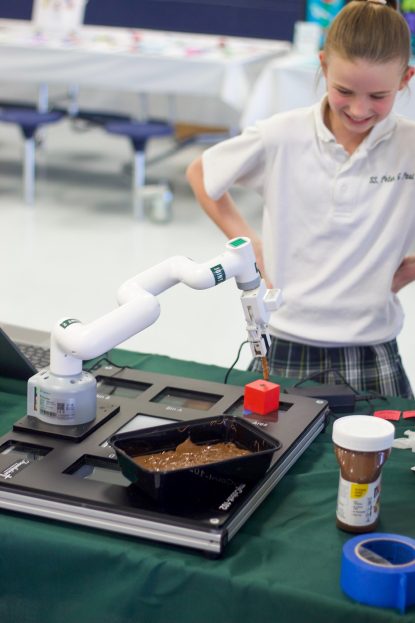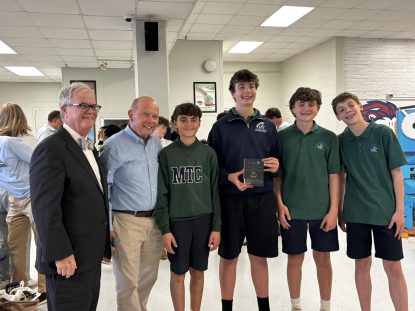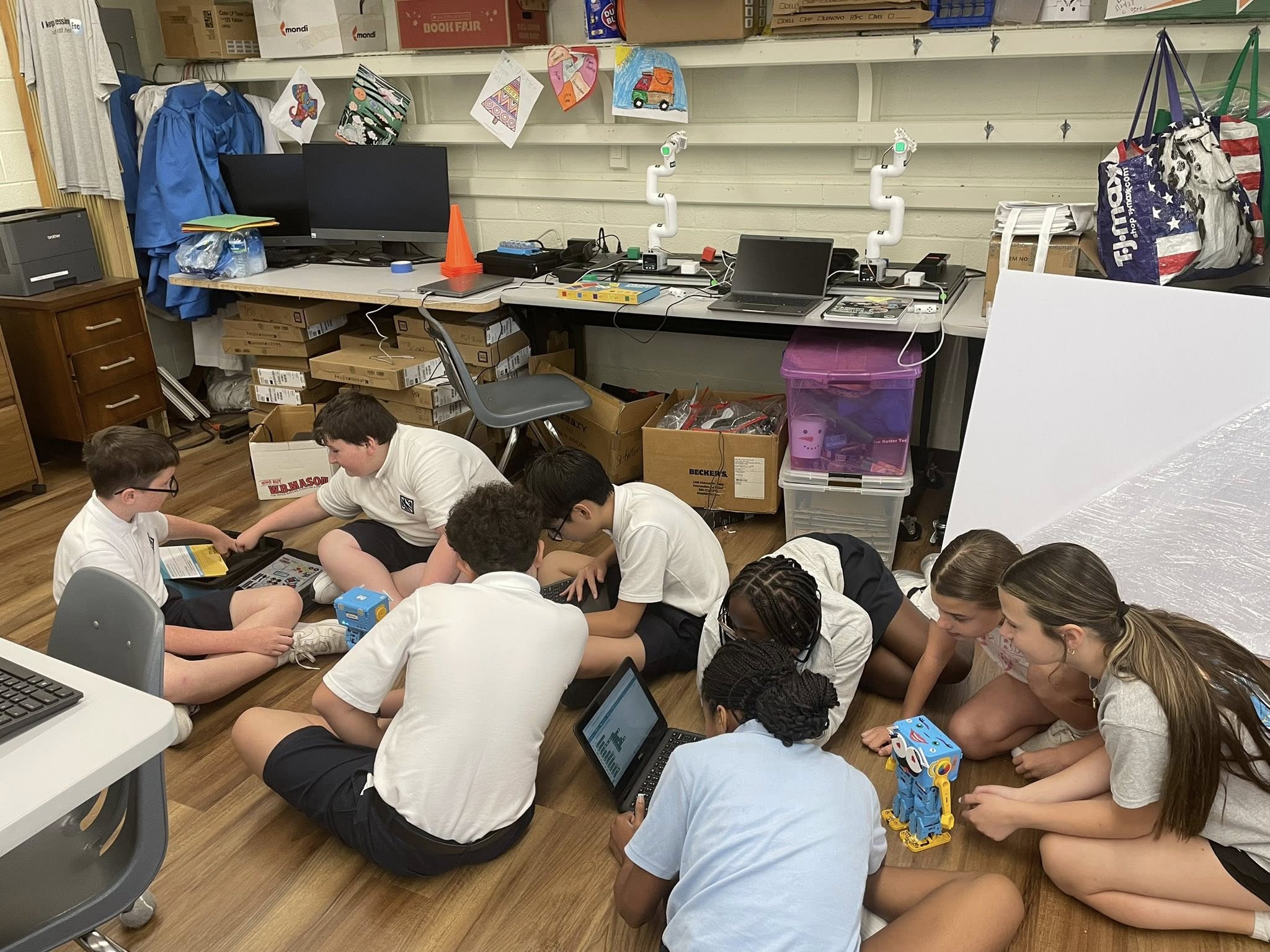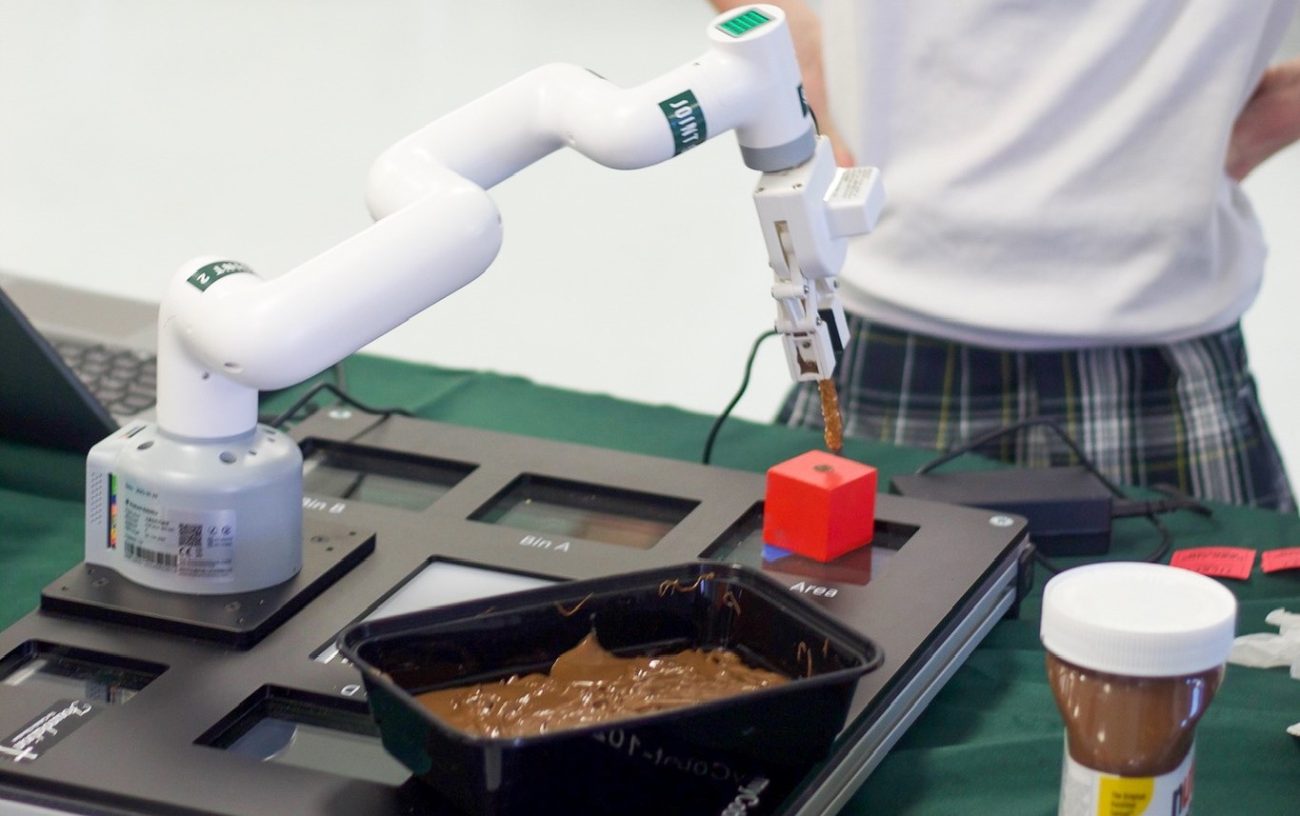
A young robotics student from SS. Peter and Paul School in West Chester showcases their coding skills as their programmed robot picks up pretzels and dips them into Nutella with precision. (Photo: Foundation for Catholic Education)
Introducing new technology to elementary students helps them learn how to create innovative solutions, work collaboratively with others, and gain confidence in a world where digital literacy is essential to their future success.
While offering robotics instruction for Catholic elementary school students began as an idea in fall 2023, this new initiative has generated a robust response from a growing number of elementary schools across the Archdiocese of Philadelphia.
St. Athanasius School in Philadelphia piloted the initiative when receiving the first set of robotic devices in January 2024.
Now students in 37 archdiocesan elementary schools are learning how to write computer code through a robotics program made possible by the Foundation for Catholic Education.
Approximately 20 more schools are planning to send teachers to training sessions this August, according to Andrew McLaughlin, Secretary of Elementary Education for the Office of Catholic Education.
The training is provided through Communications Test Design Inc. (CTDI), a global engineering, repair and logistics company based in West Chester. Jerry Parsons, CTDI chairman, also serves as president of the Foundation for Catholic Education and is a member of St. Elizabeth Parish in Chester Springs.
Introducing robotics to elementary students blends Parson’s passion for supporting Catholic education and helping students learn new technology.
“He just thought this is the way of the future, and the robotics program brings his two passions together,” McLaughlin said. “He really has helped our schools for years before this.”
Participating schools receive two myCobot 280 robot arms with corresponding laptops and five Marty the Robot devices, he explained.
“They can program Marty to do all types of stuff, and they start with him in first grade,” McLaughlin said. “There are little graphical things they can do with coding, and they progress through these coding programs until they eventually get to one called Blockly that is used in industry.”
He added that the robot arms simulate what is used in industrial settings, and the arms can be coded to do a variety of tasks.

Dr. Andrew McLaughlin, Jerry Parsons, and Mother Teresa Regional School’s 7th & 8th Grade Cobot Team celebrate their first-place win for ‘Clean Up Buddy’ on April 29 at the archdiocesan STREAM expo. (Photo: Mother Teresa Regional)
“They do things where sometimes the robots work together,” McLaughlin said. “One school had the robot decorating a Christmas tree, picking up the Christmas ball and moving it over and putting it on the tree. Sometimes they get the arms to hand things off to each other.”
Working with the robot arms is helpful for students to develop problem-solving skills, McLaughlin noted.
“If (the robot is) not doing what you want it to do, you have to go back and figure out, ‘What do I have to fix to get this to work or which code is wrong?’” he said.
Joseph Faye, IT manager and technology and digital art teacher at St. Athanasius School in Philadelphia, explained that coding is like teaching students a new language.
“When they’re younger, they can learn the language easier,” he said. “It’s a language that all kids need to learn, and I’m always surprised to see what they can do.”
The robotics curriculum for kindergarten through eighth grade students teaches them how to design, build and program robots, according to Faye who has worked at St. Athanasius for 11 years.
Faye continuously modifies the curriculum to meet the needs of the 213 students at the school.
“The curriculum always changes because when I teach, I always collect feedback to see what they were able to do, what they are comfortable with, what is too easy for them and to be able to adapt it,” he said. “I’m always updating the curriculum.”
Offering the robotics program in archdiocesan schools is part of an ongoing effort to strengthen the STREAM (Science, Technology, Religion, Engineering, Arts and Math) curriculum for students, McLaughlin said.
In addition to enhancing the elementary school curriculum, he noted that schools are interested in teaching robotics because of how engaged students are in the classroom.
“(Schools) love the fact that the kids are really motivated when they see these robots, so it’s made teaching coding fun,” McLaughlin said. “They’re just excited to be part of advancing their curriculum.”
He added that most schools have a technology or STREAM teacher, but a school can integrate robotics into math or technology classes.

Sixth grade students at St. Katherine of Siena School in Philadelphia explore the art of coding with Marty the Robot V2. (Photo: St. Katherine of Siena)
Elementary school students recently had the opportunity to demonstrate their skills in STREAM Expos and coding and robotics competition at Cardinal O’Hara in Springfield.
The STREAM Expo highlighted the importance of presenting curriculum in all STREAM content areas based on principles of the Catholic faith; demonstrating the creativity and ingenuity of collaborative learning; and illustrating how Catholic schools integrate faith values throughout the curriculum to prepare students for the future.
Ensuring students are prepared for the future is a top priority for Faye.
“We really don’t want to miss the opportunity to provide to the kids what they need for the future because otherwise we’ll have kids who will not be ready,” he said. “I’m also looking ahead for our curriculum to integrate AI into all the projects.”
McLaughlin has been impressed with the coding skills that students are developing through the robotics program.
“When we started this, I never imagined when I go in and look at schools and the things they’ve done that they’d be so creative and so skilled at writing the code,” he said. “I’ve seen a lot of creativity in different schools.”
McLaughlin emphasized that Parson’s passion for Catholic education and giving students the skills they need for the future has been essential to the success of this initiative.
“I don’t know where we would’ve been without Jerry,” he said. “We’re very fortunate to have Jerry Parsons (because) he’s done so much to help all our Catholic schools.”
PREVIOUS: Papal Foundation Makes $14M in Grants for Humanitarian Aid
NEXT: Philadelphia Leaders Reflect on Gifts, Mission of New Pope Leo XIV




Share this story